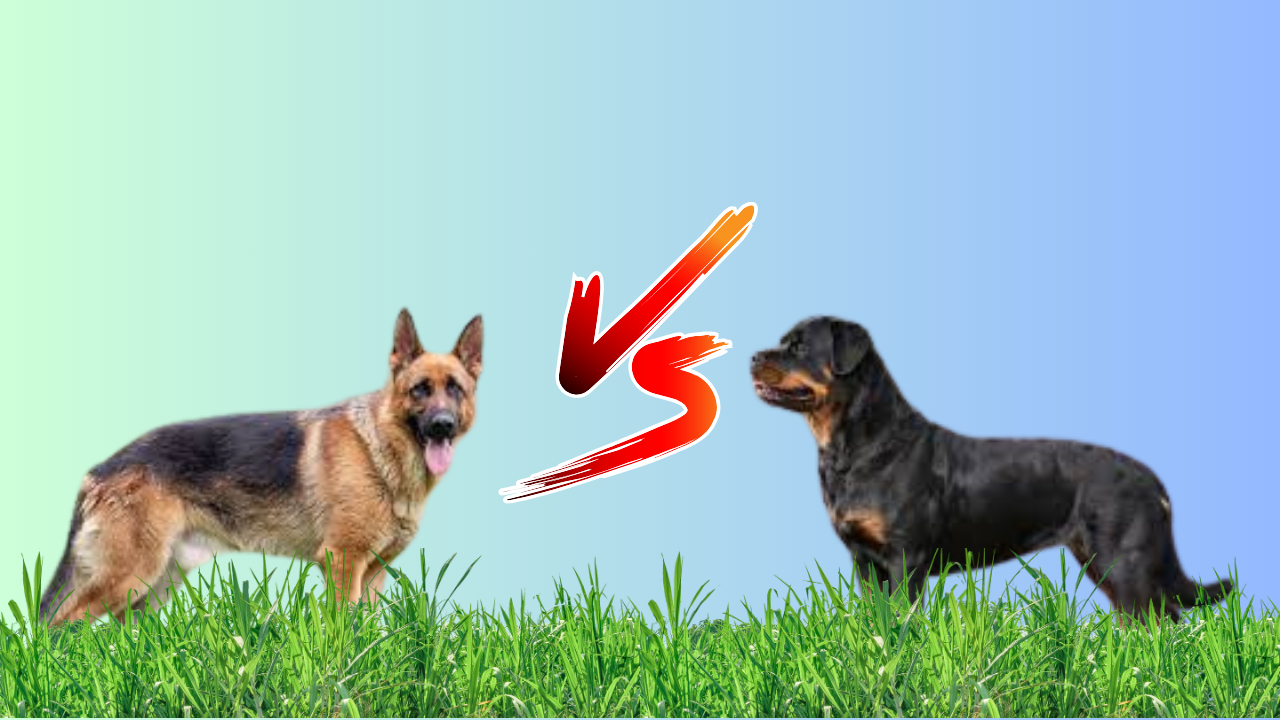When it comes to the Rottweiler dog vs German Shepherd, both are remarkable breeds with distinct traits. Rottweilers, weighing up to 135 pounds, and German Shepherds, averaging 90 pounds, have captivated dog lovers worldwide. Their intelligence and loyalty make them excellent companions for families and work roles.
As a dog enthusiast, I’ve always admired their unique traits and versatility. With lifespans of 9-14 years, they offer long-term companionship and protection. Let’s explore their differences to help you decide which fits your lifestyle best.
Quick Navigation
How do their dietary needs differ?
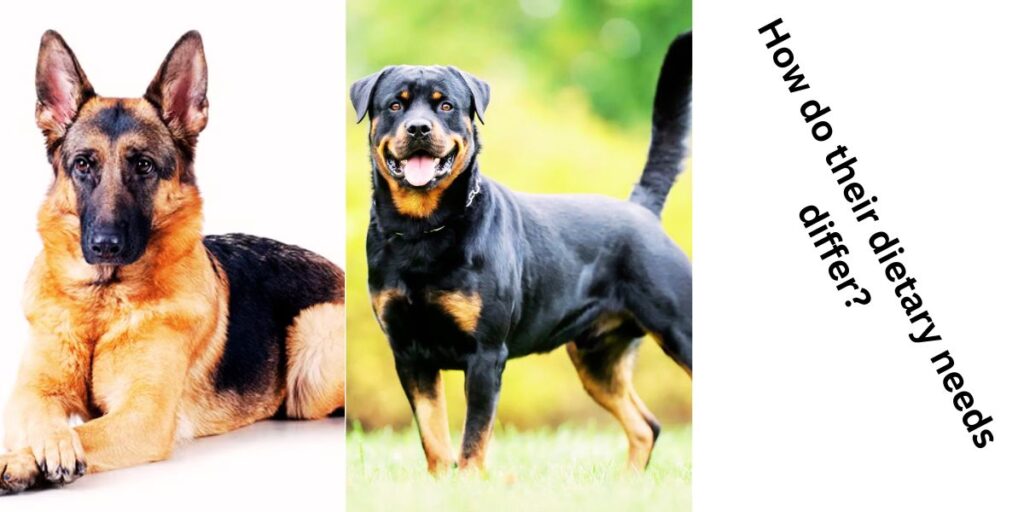
Rottweilers and German Shepherds have distinct dietary needs based on their size, activity level, and metabolism. Rottweilers, weighing 95-135 lbs, require a calorie-dense diet to support their muscular build, averaging 2,200-2,500 calories daily for active adults.
In contrast, German Shepherds, weighing 50-90 lbs, need around 1,800-2,100 calories, emphasising protein for energy and joint health. Rottweilers benefit from controlled fat intake to avoid obesity, while German Shepherds thrive on diets rich in omega-3 fatty acids for coat health.
Both breeds need high-quality food tailored to their life stage and specific health considerations like joint support or sensitive digestion.
Read more: Discover the key distinctions between the Alsatian Dog and German Shepherd in our detailed comparison.
Comparison Table
Rottweiler Dog vs German Shepherd Differences
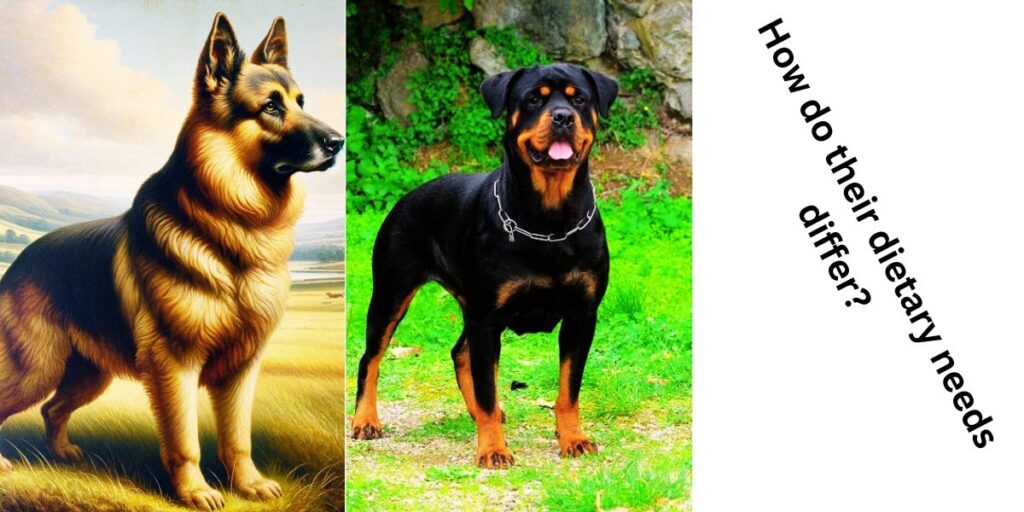
Breed Origins and History
Understanding a dog’s origin helps us appreciate its unique traits and purpose. When comparing Rottweiler Dog vs German Shepherd, both breeds have fascinating backstories tied to their roles in history.
The Origins of the Rottweiler
The Rottweiler dates back over 2,000 years to the Roman Empire. These dogs were used as herders and guardians for cattle on long military marches. Over time, Rottweilers evolved into strong working dogs, excelling in pulling carts and protecting property in Rottweil, Germany.
By the 1900s, Rottweilers gained popularity as police and military dogs due to their strength and loyalty. They remain one of the top 10 most popular breeds worldwide today. Fun fact: A Rottweiler can pull a cart weighing over 1,500 pounds!
The German Shepherd’s Journey
The German Shepherd emerged in the late 19th century, thanks to Captain Max von Stephanitz. He aimed to create the perfect working dog, combining intelligence, agility, and loyalty. The breed quickly became a favorite in herding and guarding livestock. When comparing the Rottweiler Dog vs German Shepherd, both excel in protection and working abilities, but their temperament and training needs differ.
By the early 20th century, German Shepherds were recognized for their versatility and began serving in military and police roles during World War I. Today, they’re the third most popular breed in the United States, admired for their unmatched versatility.
Read more: Find out how the Belgian Malinois and German Shepherd differ to choose the best dog for your lifestyle.
Physical Characteristics
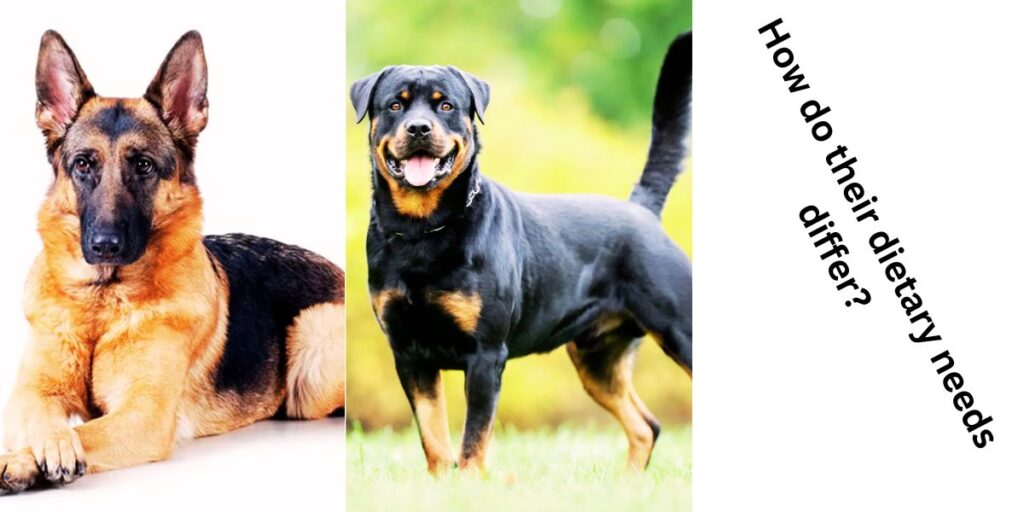
When comparing the physical attributes of Rottweilers and German Shepherds, their distinct features stand out. Let’s look at their size, coat, and lifespan to understand their build and appearance better in the Rottweiler Dog vs German Shepherd comparison.
Size and Weight
Rottweilers are a powerhouse of strength. Males stand at 24-27 inches tall and weigh 95-135 pounds, while females are slightly smaller at 22-25 inches and weigh 80-100 pounds. Their robust frame makes them ideal for guarding.
German Shepherds are slightly leaner and more athletic. Males reach 24-26 inches in height, weighing 65-90 pounds, while females are 22-24 inches tall, weighing 50-70 pounds. Their agility gives them a dynamic edge.
Coat and Color
Rottweilers are known for their sleek, dense black coat adorned with striking rust markings. This short coat is low-maintenance, requiring brushing just once a week to control shedding.
German Shepherds, on the other hand, flaunt a medium-length double coat. Their color options are diverse, including classic black and tan, sable, and even solid black. They shed heavily, demanding frequent brushing.
Lifespan
Rottweilers typically live between 9-10 years. Their shorter lifespan is often due to their size and predisposition to certain health issues, which we’ll discuss later.
German Shepherds enjoy a longer lifespan of 10-14 years. This gives them an edge for families looking for a loyal companion with a few extra years of companionship.
Temperament and Personality
Understanding the temperament of Rottweilers and German Shepherds is key when choosing the right companion. Both breeds have unique qualities that make them exceptional in their own ways.
Rottweiler Personality Traits
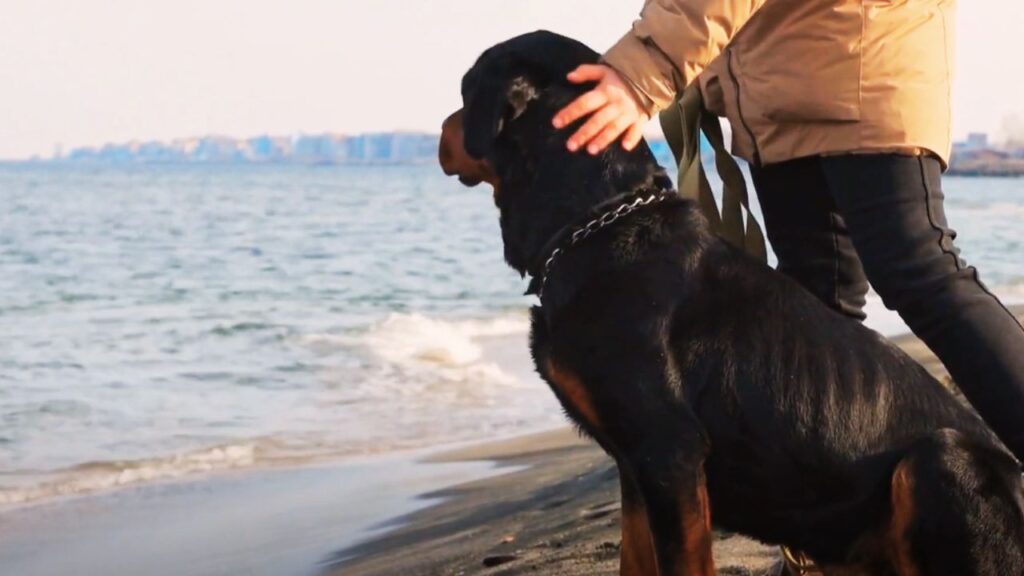
Rottweilers are known for their confident and protective nature. They’re deeply loyal and form strong bonds with their families. Interestingly, about 90% of Rottweilers are naturally reserved around strangers but show incredible affection to those they trust.
This breed is a natural guardian, making them excellent for homes needing security. Despite their serious demeanor, they have a playful side and enjoy activities that engage them both mentally and physically.
German Shepherd Personality Traits
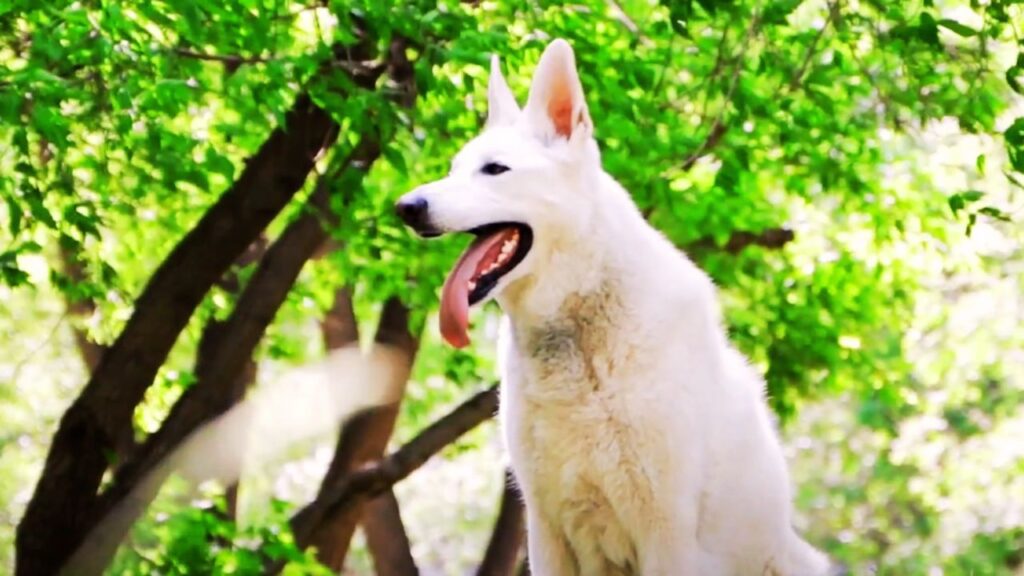
German Shepherds are celebrated for their intelligence and obedience. Ranking third in canine intelligence, they excel in understanding commands and adapting to new situations. This makes them highly dependable as working dogs.
These dogs are social butterflies with a protective streak. They’re generally more approachable than Rottweilers and are fantastic with children, with 75% of surveyed owners reporting them as patient and nurturing family pets.
Comparing Their Loyalty and Behavior
Both breeds are exceptionally loyal, but they express it differently. A Rottweiler might stick close to you at home, guarding your space, while a German Shepherd might enjoy accompanying you on outings. Both thrive on attention and affection, ensuring they’ll always be by your side
Trainability and Intelligence
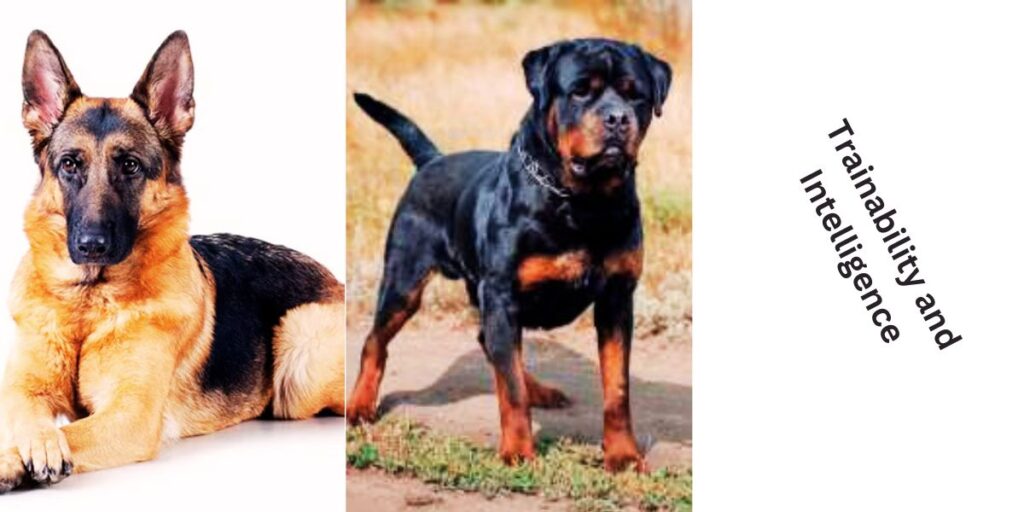
Both Rottweilers and German Shepherds are intelligent and highly trainable, making them excellent working dogs. However, each breed has unique traits that influence their learning style and responsiveness to training.
Rottweiler: Loyal but Stubborn
Rottweilers are quick learners and respond well to positive reinforcement. They rank 9th in intelligence among dog breeds, excelling in tasks requiring focus. While they’re loyal and eager to protect, they can be slightly stubborn, making consistency key during training.
German Shepherd: The Obedience Champion
German Shepherds are famously ranked 3rd in intelligence among dogs, just behind Border Collies and Poodles. They thrive in obedience training, mastering commands after only 5 repetitions. Their natural drive to please makes them ideal for roles in police and military work.
How They Compare
While both breeds are intelligent, German Shepherds tend to outshine Rottweilers in structured obedience tasks. Rottweilers excel in guard training and have a keen instinct for independent decision-making. Both need 15-30 minutes of mental stimulation daily to prevent boredom.
Exercise and Activity Needs
Both Rottweilers and German Shepherds are energetic breeds. Understanding their exercise requirements is crucial for a happy, healthy pet.
Rottweiler: Moderate but Intense Exercise
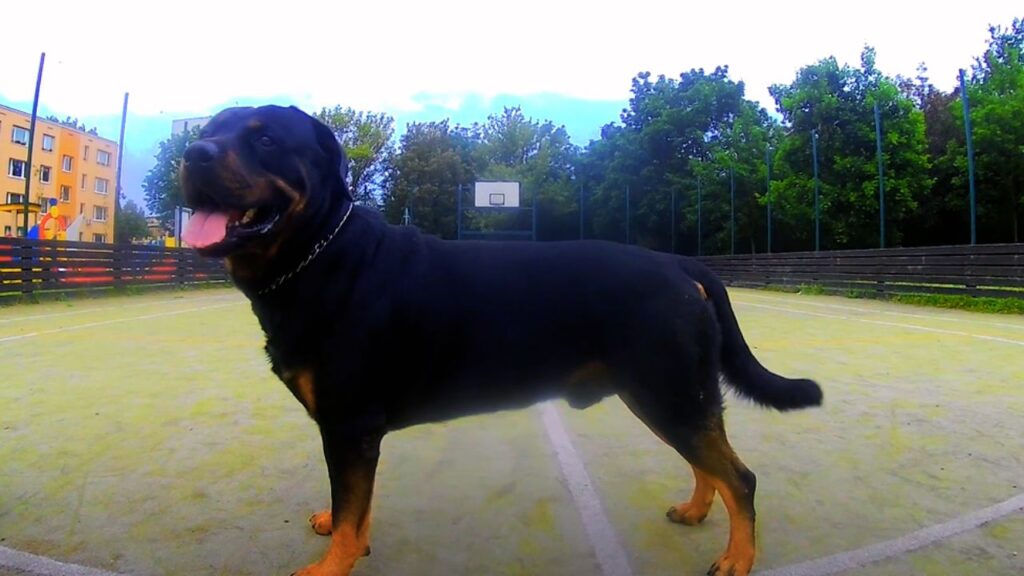
Rottweilers thrive with about 60 minutes of daily activity. They enjoy strength-building activities like pulling or agility exercises. While they love playing, over-exercising a puppy under 18 months can harm their joints.
German Shepherd: High Energy Demands
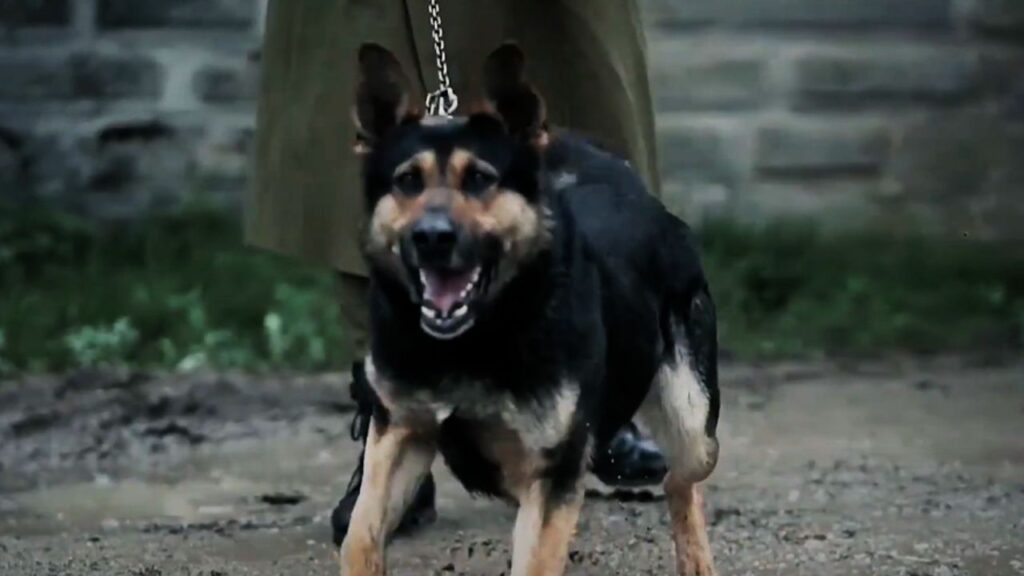
German Shepherds need around 120 minutes of activity daily. They excel in endurance-based activities like hiking or running. Their high intelligence also means they require mental challenges, like obedience training or puzzles.
Shared Benefits of Structured Activities
Both breeds love structured games like fetch, which improve focus and burn energy. A weekly mix of physical and mental stimulation ensures a balanced lifestyle. These activities also strengthen the bond between you and your dog
Health Considerations
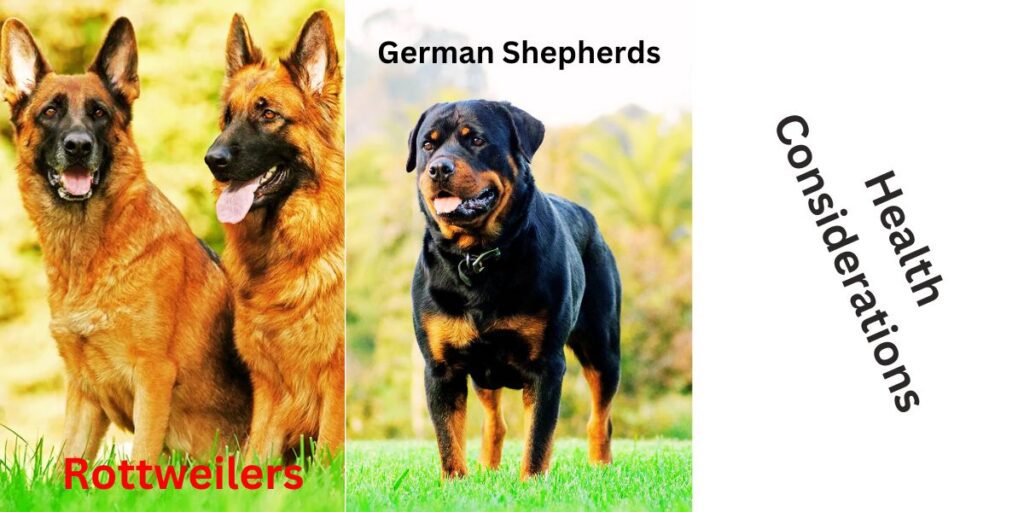
Taking care of a dog means understanding its health. Both Rottweilers and German Shepherds have unique needs that every owner should know. Let’s explore their common health issues and grooming demands.
Common Health Issues
Rottweilers often face joint-related issues like hip dysplasia, which affects about 20% of the breed. They’re also prone to heart conditions and cancers, especially bone cancer, which occurs in nearly 12% of Rottweilers. Regular vet check-ups are a must!
German Shepherds also deal with hip dysplasia, affecting approximately 19% of them. However, they are more likely to experience bloat and degenerative myelopathy, a spinal condition seen in 2% to 3% of the breed. Monitoring their diet and exercise is essential.
Grooming Needs
Rottweilers have a low-maintenance coat that sheds moderately. A simple brushing once a week helps manage their dense fur and keep their skin healthy. Bathing them every 6 to 8 weeks is usually enough.
German Shepherds shed a lot more, thanks to their double coat. Weekly brushing is the bare minimum; during shedding season, you’ll need to brush them 2-3 times a week. Frequent baths are unnecessary, with one every 8-12 weeks being sufficient. Learn the differences between the Anatolian Shepherd and Kangal Dog to understand which breed suits your needs better.
Suitability for Families and Living Environments
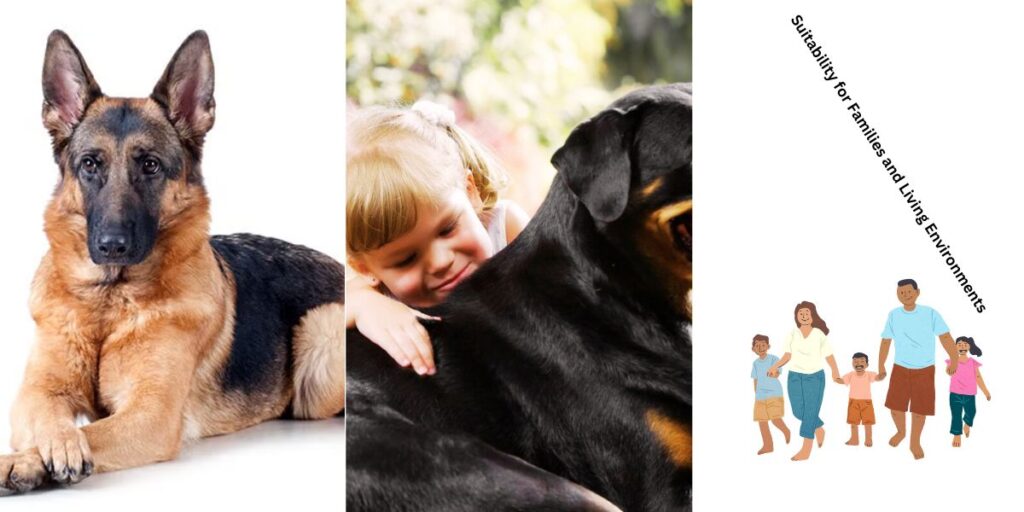
Finding the perfect dog for your home often depends on your family setup and living space. Let me walk you through how Rottweilers and German Shepherds fit into different environments.
Family-Friendly Companions
Rottweilers are surprisingly gentle giants despite their tough looks. They bond deeply with families, but they might take time to warm up to strangers. With proper training, they’re excellent protectors and loving pets, especially for families with older children.
German Shepherds are naturals with kids, often acting as protective nannies. With their high energy levels, they thrive in active households. Did you know that 75% of German Shepherd owners report them being amazing with children under 10?
Living Space Adaptability
Rottweilers do well in apartments as long as they get 60 minutes of daily exercise. Their calm nature indoors makes them suitable for smaller spaces. However, a backyard where they can roam freely is a plus.
German Shepherds, on the other hand, need more room to burn off their energy. They require 90-120 minutes of exercise every day, making them better suited for homes with large yards or active families who love outdoor adventures.
Socialization Needs
Both breeds need early socialization to thrive in a family environment. Rottweilers are more reserved, requiring consistent exposure to different people and pets. German Shepherds are more naturally sociable but still need structured interaction
Roles and Work Capabilities

Both Rottweilers and German Shepherds are working breeds, excelling in various roles. Let’s dive into how each breed performs in guarding, service, and specialized tasks.
Rottweiler’s Traditional Roles
Rottweilers were originally bred for herding and guarding cattle. They are powerful dogs, capable of pulling carts with loads weighing up to 1,500 pounds in their early days. Today, they’re still trusted for guarding and protection roles due to their strength and loyalty.
Rottweilers in Modern Work
This breed thrives in police and military work, excelling in search-and-rescue missions. Around 20% of Rottweilers trained in search-and-rescue are deployed globally, showcasing their reliability. They’re also often chosen for personal protection due to their intimidating presence and intelligence.
German Shepherd’s Versatile Skills
German Shepherds are renowned for their versatility. They dominate in police and military forces, with over 40% of K9 units worldwide using German Shepherds. Their keen sense of smell and obedience make them ideal for tracking and detection tasks.
German Shepherds in Service and Rescue
This breed is also a top choice for service work, including guiding visually impaired individuals. Their ability to follow over 100 commands makes them an excellent partner for people with disabilities. They are widely recognized as lifesavers in search-and-rescue missions, especially during natural disasters.
Which Breed Suits Your Needs?
Both breeds excel in various roles, but it’s essential to match their strengths to your needs. If you need a loyal protector, a Rottweiler might be your pick. For a versatile, highly trainable working partner, the German Shepherd stands out
Wrap Up
Choosing between a Rottweiler and a German Shepherd depends on your lifestyle. If you prefer a strong, protective dog, the Rottweiler may be your match, especially with their 95-135 lbs build. On the other hand, the German Shepherd’s adaptability and 10-14 year lifespan make them a versatile choice.
When I think about “rottweiler dog vs german shepherd,” it’s clear both breeds are exceptional in their own ways. Ultimately, your decision should align with your family’s needs, living space, and energy level.

